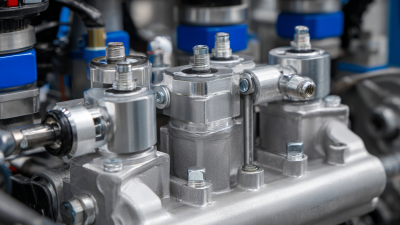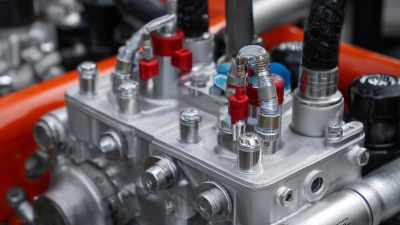Exploring the Future of Fluid Power Hydraulics in Innovative Industries
The future of fluid power hydraulics stands at the intersection of innovation and efficiency, with industries increasingly relying on advanced hydraulic systems to meet the demands of modern applications. According to a recent report by MarketsandMarkets, the fluid power market is projected to reach $60.47 billion by 2025, reflecting a compound annual growth rate (CAGR) of 5.73% from 2020. This growth is driven not only by increased demand in traditional sectors such as construction and manufacturing but also by the emergence of innovative industries like renewable energy, robotics, and automation.

As organizations strive for greater sustainability and operational efficiency, the role of fluid power hydraulics becomes even more critical. The integration of digital technologies and smart systems is revolutionizing how hydraulic systems operate, allowing for real-time monitoring and enhanced performance. Furthermore, the relentless push towards reducing carbon footprints and improving energy efficiency is leading to a significant shift in hydraulic design and operation, emphasizing the need for continuous research and development. The challenges and opportunities presented in this evolving landscape call for a closer exploration of fluid power hydraulics and its transformative potential in shaping the future of various industries.
Emerging Trends in Fluid Power Technology: A Comprehensive Overview
Fluid power technology is rapidly evolving, and its applications in innovative industries are becoming increasingly significant. Recent reports, such as those from the International Fluid Power Society (IFPS), indicate a projected growth rate of over 6% in the fluid power market through 2027. This growth is fueled by advancements in smart hydraulics, enabling greater precision and efficiency in systems ranging from construction equipment to robotics. Moreover, the integration of IoT in fluid power systems is enhancing real-time monitoring and predictive maintenance, thereby reducing downtime and operational costs.
As companies strive to remain competitive, embracing these emerging trends is crucial. Advanced materials, for instance, are paving the way for lighter and more durable hydraulic components, contributing to enhanced system performance. According to a study by Market Research Future, the global hydraulic systems market is anticipated to reach USD 45 billion by 2025, driven by innovations in energy efficiency and automation.
Tip: Businesses should consider investing in training for their workforce to fully leverage the benefits of new fluid power technologies and ensure proper implementation.
Another exciting trend is the increasing focus on sustainability within the fluid power sector. Companies are developing hydraulic systems with lower environmental impact by incorporating biodegradable fluids and energy-efficient designs. This shift aligns with global sustainability goals and is reshaping how industries approach fluid power applications.
Tip: Regularly assess your hydraulic systems for efficiency and environmental impact to align with industry best practices and sustainability initiatives.
Applications of Hydraulics in Renewable Energy Sectors
The integration of fluid power hydraulics in the renewable energy sector is revolutionizing how we harness and utilize natural resources. Hydraulics systems are becoming increasingly vital in the operation of equipment such as wind turbines and solar panel trackers. These systems ensure that energy generation components function efficiently, adapting to changing environmental conditions to maximize energy output. By providing the necessary force in a compact design, hydraulics enhance the capability of renewable energy technologies to deliver consistent and reliable performance.
**Tip:** When considering hydraulic applications in renewable energy, prioritize systems that allow for real-time monitoring and adjustability. This adaptability is crucial for optimizing energy production based on varying wind speeds or solar intensity.
Additionally, innovative developments in hydraulic technology are paving the way for more sustainable energy solutions. For example, the use of biodegradable hydraulic fluids helps minimize environmental impact, making hydraulic systems not only efficient but also eco-friendly. As industries increasingly incorporate these innovations, the role of hydraulics in renewable energy is set to grow significantly, creating greener solutions for energy challenges.
**Tip:** Always evaluate the environmental certifications of hydraulic components and fluids being used in renewable projects. Opting for eco-friendly options supports both sustainability and regulatory compliance.
Exploring Applications of Hydraulics in Renewable Energy Sectors
Integrating Smart Technologies into Fluid Power Systems
The integration of smart technologies into fluid power systems is reshaping industries by enhancing efficiency and precision in operations. With the advent of the Industrial Internet of Things (IIoT), fluid power systems are becoming increasingly interconnected, allowing for real-time monitoring and data analysis. This connectivity enables predictive maintenance, reducing downtime and operational costs. Advanced sensors and artificial intelligence algorithms provide valuable insights into system performance, helping operators make informed decisions and optimize their processes.
Moreover, the use of smart actuators and electronically controlled hydraulic systems is facilitating more adaptable and responsive operations. These technologies allow for fine-tuning of power delivery, ensuring that energy is used more effectively while improving overall system responsiveness. As industries continue to innovate, the convergence of fluid power with smart technologies will drive sustainability efforts, leading to greener practices and reduced environmental impact. The future of fluid power hydraulics lies in harnessing these advancements to create more intelligent, efficient, and sustainable systems across various sectors.
Sustainability Practices in Fluid Power Industries
Sustainability has emerged as a crucial focus for industries reliant on fluid power hydraulics. As companies strive to reduce their environmental footprint, innovative practices are being adopted to enhance energy efficiency and minimize waste. Modern hydraulic systems are now designed with advanced materials and technology that not only improve performance but also contribute to sustainable practices. For instance, the integration of biodegradable hydraulic fluids and energy recovery systems reduces the ecological impact of hydraulic operations, allowing industries to operate more responsibly.
Furthermore, the shift towards renewable energy sources offers an exciting opportunity for the fluid power sector. By harnessing solar, wind, and other renewable energies, hydraulic systems can be significantly enhanced, leading to more efficient operations and reduced reliance on fossil fuels. This transition not only improves the carbon footprint of hydraulic applications but also opens doors to innovative processes and technologies. As industries embrace sustainability, the future of fluid power hydraulics appears bright, characterized by a commitment to both performance and environmental responsibility.
Future Challenges and Opportunities in Hydraulic Engineering
The field of hydraulic engineering is continuously evolving, and with it come both challenges and opportunities that shape its future. One of the primary challenges facing hydraulic systems is the need for increased efficiency and sustainability. As industries push towards greener solutions, hydraulic engineers must innovate in design and material selection to reduce energy consumption and environmental impact. This includes the development of advanced hydraulic fluids and systems that minimize waste while maximizing performance.
On the other hand, the increasing demand for automation and precision control in innovative industries, such as robotics and renewable energy, presents significant opportunities. Hydraulic engineering can capitalize on these trends by integrating smart technologies and IoT solutions to create systems that are not only efficient but also adaptive to changing operational conditions. By harnessing data analytics and machine learning, hydraulic engineers can develop predictive maintenance strategies, leading to enhanced reliability and reduced downtime. The future of fluid power hydraulics thus lies in embracing these technological advancements while addressing the pressing challenges facing the industry.
Related Posts
-

5 Best Fluid Power Hydraulics Solutions for Optimal Performance
-

Why Fluid Power Hydraulics Are Essential for Modern Industry
-

Ultimate Checklist for Global Buyers in Fluid Power Procurement
-

What Are the Key Components of Hydraulics Products and Their Applications
-

Exploring the Synergy of Pneumatic and Hydraulic Systems in Modern Industrial Applications
-

Exploring Hydraulic Continental Solutions at the 138th Canton Fair 2025 Trends and Market Data
 skip to Main Content
skip to Main Content
